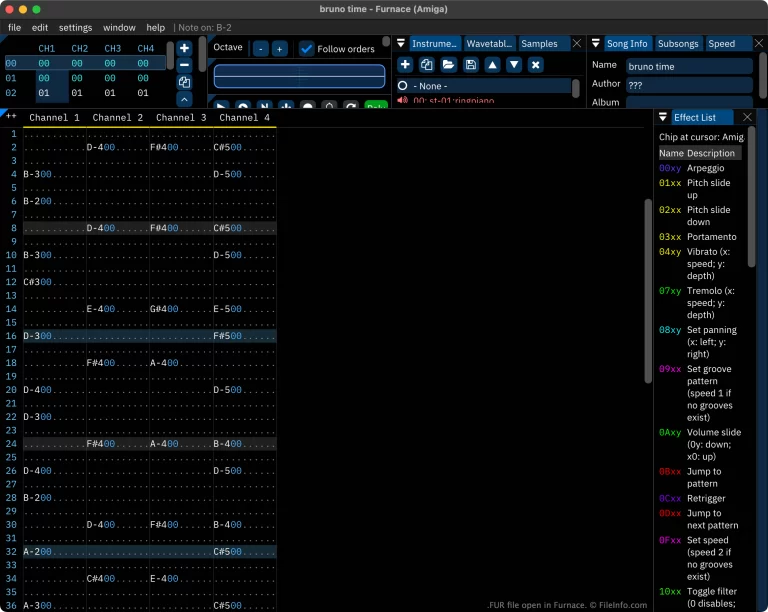.FUR File Extension

Furnace Module
| Developer | tildearrow |
| Popularity | |
| Category | Audio Files |
| Format | .FUR |
| Cross Platform | Update Soon |
What is an FUR file?
File extensions are essential components of digital data. They indicate the format and content of a file, allowing various software applications to interpret and process the data within. One such file extension is “.FUR,” which may not be as widely recognized as .jpg or .pdf, but it serves its purpose in specific contexts.
In this article, we will delve into the FUR file extension, exploring its origins, history, technical specifications, advantages, disadvantages, and how to open it on various operating systems.
More Information.
FUR files were first introduced to streamline the rendering of fur and hair in 3D models. They emerged as a solution to improve the visual quality and realism of virtual characters in movies, video games, and simulations.
The ability to manipulate fur and hair with precision became a significant asset for animators and designers, making FUR files an essential tool in the industry.
Origin Of This File.
The FUR file extension has its roots in the world of 3D modeling and animation. It is primarily associated with software used for fur rendering and hair simulation in computer graphics.
These files contain data related to the appearance, movement, and texture of fur or hair in 3D models. They play a crucial role in creating realistic and visually appealing virtual characters and creatures.
File Structure Technical Specification.
FUR files consist of complex data structures, including information about the length, color, and texture of individual fur strands.
They also store data related to the physics of fur, such as how it moves and interacts with the environment. This data is often represented in binary format, optimized for quick rendering and real-time simulations.
How to Convert the File?
Converting FUR files may be necessary to make them usable in different applications or to share them with others. The process depends on the source and destination formats.
Here are some general steps to convert FUR files:
Open in Windows
- Use 3D modeling software like Autodesk Maya or Blender, which often support FUR files natively.
- Export the FUR file to a more common format like OBJ, FBX, or Collada for compatibility with other Windows software.
Open in Linux
- Employ open-source 3D modeling and animation software like Blender or Wings 3D, which are available on Linux platforms.
- Use these tools to work with FUR files or convert them to a compatible format.
Open in Mac
- Mac users can utilize 3D software like Maya or Cinema 4D, which offer Mac-compatible versions.
- Convert FUR files to popular formats like FBX or OBJ if needed.
Open in Android
Opening FUR files on Android devices can be challenging due to the complexity of 3D modeling tasks. Consider using cloud-based 3D modeling solutions if necessary.
Open in iOS
As with Android, iOS devices are not typically equipped for native FUR file handling. Utilize cloud-based solutions or transfer files to a desktop for processing.
Open in Others
For less common operating systems, it may be necessary to rely on cross-platform 3D modeling and animation software or cloud-based solutions to handle FUR files.
Advantages And Disadvantages.
Advantages
- Realism: FUR files enable the creation of incredibly realistic fur and hair in 3D models, enhancing visual quality.
- Precision: They provide fine control over fur properties, allowing artists to achieve the desired look.
- Versatility: FUR files are compatible with a wide range of 3D modeling and animation software, making them accessible to many professionals.
Disadvantages
- Complexity: Working with FUR files can be challenging due to their intricate data structures and requirements.
- Resource-Intensive: Rendering high-quality fur can be computationally demanding, requiring powerful hardware.
- Limited Scope: FUR files are specialized and may not be relevant for projects that do not involve 3D modeling and animation.
How to Open FUR?
Open In Windows
- If the file format is associated with a specific application, you can try opening it directly in that program.
- If it’s a text-based format, you can use a text editor such as Notepad or Notepad++ to view the contents.
Open In Linux
- Use the terminal to navigate to the file location and use command-line tools to open and view the contents.
- Use a text editor like Vim, Nano, or Gedit to view text-based formats.
Open In MAC
- If the file format is associated with a specific application, you can try opening it directly in that program.
- Use a text editor like TextEdit or a code editor like Visual Studio Code to view text-based formats.
Open In Android
- Install a file manager app from the Google Play Store that allows you to navigate through the file system and open different file types.
- For text-based formats, various text editor apps are available on the Play Store.
Open In IOS
iOS has more restricted file management compared to other operating systems. You might need to use specific apps designed to handle the “FUR” file format.
Open in Others
- The process may vary for less common or specialized operating systems.
- Generally, follow similar steps: identify the software or format, use text editors or viewers, and search for specialized software.













